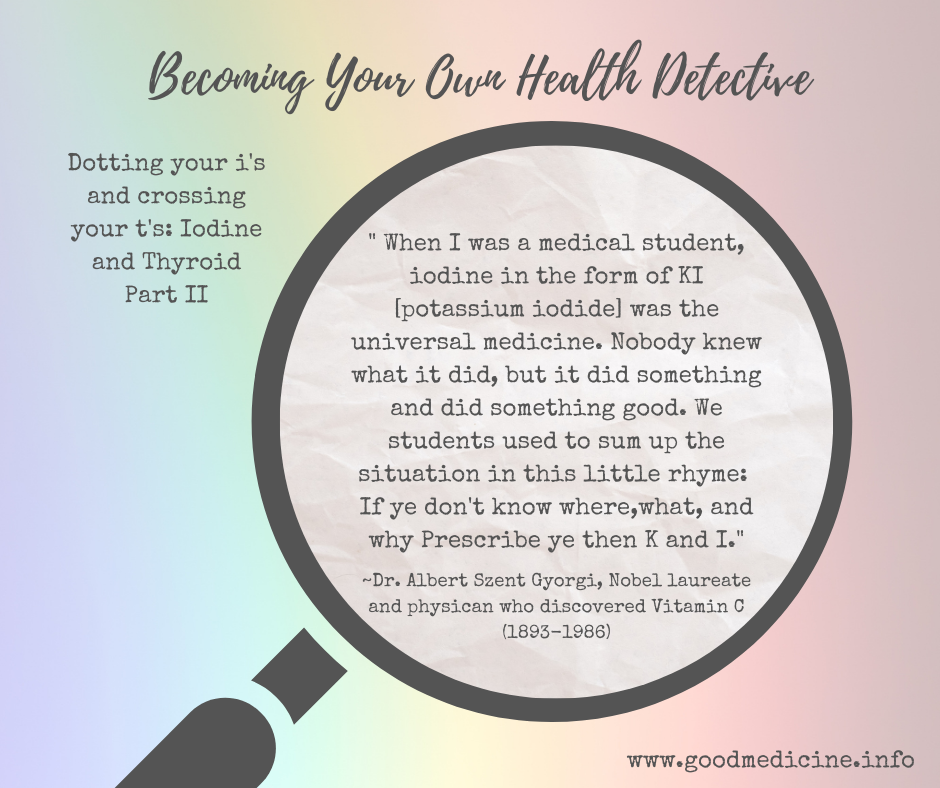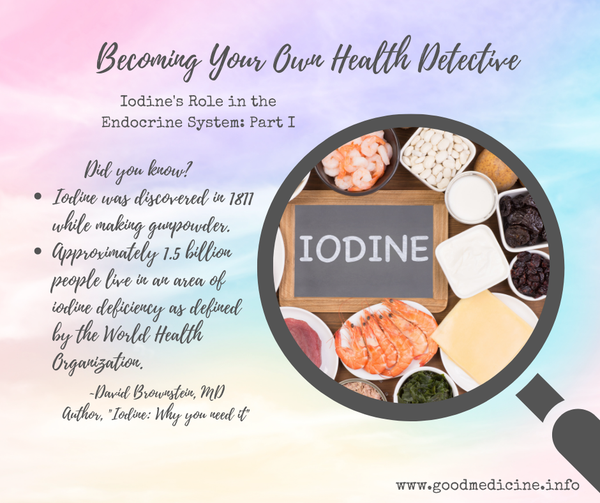Dotting your i’s and crossing your t’s: Iodine and Thyroid Part II
Looking for clues is like using a roadmap . The clues
. The clues you find along the way will help you get to your destination. Sometimes you’ll need to stop and ask for directions from a local, someone who knows the territory well. Part II of dotting i’s and crossing t’s may very well require the assistance of an iodine savvy endocrinologist
you find along the way will help you get to your destination. Sometimes you’ll need to stop and ask for directions from a local, someone who knows the territory well. Part II of dotting i’s and crossing t’s may very well require the assistance of an iodine savvy endocrinologist  or astute thyroid knowledgeable health professional who can help you find your perfect balance. You’ll need someone who listens to your clues, is willing to dig with you, understands the Great Iodine Debate, and doesn’t put you in a box with everyone else.
or astute thyroid knowledgeable health professional who can help you find your perfect balance. You’ll need someone who listens to your clues, is willing to dig with you, understands the Great Iodine Debate, and doesn’t put you in a box with everyone else.
The Great Iodine Debate Summary
The “Great Iodine Debate” has been going on for many years and it’s well worth it to dive as deep as you need to. There is no possible way to cover everything on each topic I discuss. That’s not the point of this series anyway. My hope is that something you read sparks an “ah ha” moment and inspires you to dig more, putting pieces together for your individually unique puzzle. These “ah ha” moments are usually Holy Spirit led. If you feel a niggling in your soul, pay attention to it, and do your digging (due diligence) and use your tools to bring your body back into balance.
Dr. Guy E Abraham MD’s work surrounding iodine (formerly of the UCLA Department of Endocrinology) would be considered the modern catalyst for reviving the “Great Iodine Debate”. Interestingly, most of his personal information and work appears to have been scrubbed from the internet. As a  seasoned sleuther, it’s clues like this (the scrubbing) that make me look even closer at what this “outside the box thinking” doctor had to say. (This is another reason I rely on my personal library more than the internet when digging for clues.)
seasoned sleuther, it’s clues like this (the scrubbing) that make me look even closer at what this “outside the box thinking” doctor had to say. (This is another reason I rely on my personal library more than the internet when digging for clues.)
Take for instance, this quote from Dr. Abraham:
“During the first half of the 20th century, almost every U.S. physician used Lugol solution for iodine supplementation in his/her practice for both hypo- and hyperthyroidism, and for many other medical conditions. In the old pharmacopeias, Lugol solution was called Liquor Iodi Compositus. The minimum dose called minim, was one drop containing 6.25 mg of elemental iodine, with 40% iodine and 60% iodide as the potassium salt. The recommended daily intake for iodine supplementation was 2 to 6 minims (drops) containing 12.5 to 37.5 mg elemental iodine. During the second half of the 20th century, iodophobic misinformation disseminated progressively and deceitfully among the medical profession resulted in a decreased use of Lugol, with iodized salt becoming the standard for iodine supplementation. The bioavailable iodide from iodized salt is only 10% and the daily amount of iodide absorbed from iodized salt is 200 to 500 times less than the amount of iodine/iodide previously recommended by U.S. physicians. After World War II, U.S. physicians were educated early in their medical career to believe that inorganic non-radioactive forms of iodine were toxic. Adverse reactions to radiographic contrast media and other iodine-containing drugs were blamed on iodine. If a patient told his/her physician that he/she could not tolerate seafood, the physician told him/her that he/she was allergic to iodine.”
Things that make me go hmmmmmmm. Onward…. Shall we?
Here is How to Test for Iodine:
Common Questions
If your roadmap is leading to a possible iodine deficiency, you probably have a few questions. I’ll try to address some of them here.
A: Yes. Though it is considered one of the safest of our micronutrients when it is in inorganic, nonradioactive form ( iodides, tincture of iodine, Lugol solution). Iodine induced hypothyroidism is incredibly rare. TSH may rise when initially supplementing but T3 and T4 do not fall (those are the “boots on the ground” thyroid hormones you want to watch closely).
Short answer…. No. Remember, we are all uniquely made. How do you feel? What symptoms are you living with? What is your risk category (see previous post) based on the factors involved?
Also, there is an uncommon situation called iodine induced hyperthyroidism. This occurs when there is an autonomously functioning thyroid nodule. This means that the nodule is not taking directions from the feedback mechanism involving the pituitary and the hypothalamus (go back and re-read the post on the “upstream” players in thyroid function if needed). An independent functioning nodule is like a wayward teenager….. It does its own thing in the presence of iodine regardless of the guidance mechanisms in place to prevent that from happening and hyperthyroidism can result. This is diagnosed with a thyroid scan, and iodine will need to be avoided until the nodule can be removed.
You might also recall iodine’s close association with fluorine, bromine, and chlorine. When iodine levels increase in the body, this can cause a mobilization of toxins that bind to the same receptor sites. Mobilized toxins are like a gang of thugs on the move causing various degrees of mayhem until they have been excreted.
on the move causing various degrees of mayhem until they have been excreted.
For this reason….. Easy does it friend! Lower levels of iodine/iodide supplementation are your friend ( Master Formula, Multigreeens and Thyromin), as is making sure you are flushing out toxins by staying well hydrated, and taking adequate amounts of Vitamin C ( YL’s Super C Chewables is a stellar choice), and a regular source of antioxidants ( NingXia Red!). Should you find out you need more iodine/iodide in your life, there are products available as stand alone entities. Talk to your iodine savvy health professional if you think you need more.
An actual true allergy to inorganic iodine/iodide is very very rare. More commonly “iodine allergies” can be traced back to the body’s response to the other chemicals or allergens found within the same product or food item. Oftentimes the link is seafood or shellfish
or shellfish  , contrast dyes, iodine antiseptics. Iodine’s molecule is small and too simple (structure wise) to cause an antibody response, but when it’s combined with another substance, it could play a role in the allergic response. Example: some people may have a topical reaction to the antiseptic povidone-iodine but have no reaction to potassium iodide.
, contrast dyes, iodine antiseptics. Iodine’s molecule is small and too simple (structure wise) to cause an antibody response, but when it’s combined with another substance, it could play a role in the allergic response. Example: some people may have a topical reaction to the antiseptic povidone-iodine but have no reaction to potassium iodide.
Frankly, this is a problem and why it’s a good idea to evaluate your iodine load. If you are on thyroid medication and still don’t feel “right”…. It could be that your medication needs tweaking or changing….. Or it could be related to an iodine deficiency that may account for some (or all) of the symptoms you are feeling.
Additionally, one of the jobs of thyroid hormone is to stimulate metabolism. Every cell in the body is dependent upon iodine for proper metabolic function. If supplemental thyroid hormone raises the metabolism of cells throughout the body, this also increases the need for iodine (that may or may not be there). Recall last week’s discussion on iodine’s role in cellular function which includes programmed cell death (a good thing!). Frankly, knowing this information, I believe that people on thyroid medication should be tested for iodine deficiency regularly.
The mainland Japanese ingest over 100x the RDA of iodine in their diet. Coincidentally, they have among the lowest incidence of breast, endometrial, ovarian, and prostate cancers (and a very low incidence of fibrocystic breast disease too).
Interestingly, there is a strong correlation between higher levels (and severity) of ADHD and autism in iodine deficient populations. Kids can be tested for iodine deficiency too….. Their loading challenge will be different based on weight. You’ll want to work with an iodine knowledgeable pediatric health professional who will work with you.
If you’d like to dive more into the “Great Iodine Debate”, I’d encourage you to pick up a copy of any of these books:
As always…. I’m here simply to be your super sleuth guide. You are your own best health detective!
xoxo~ liz


